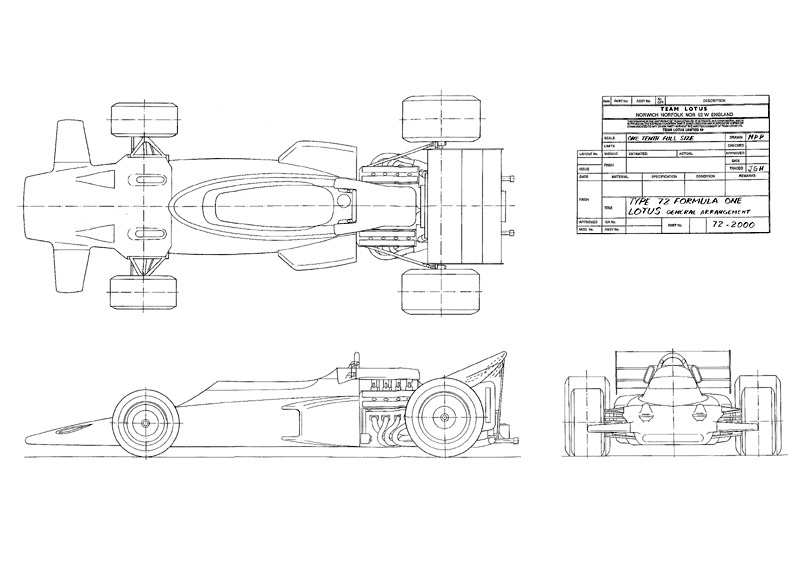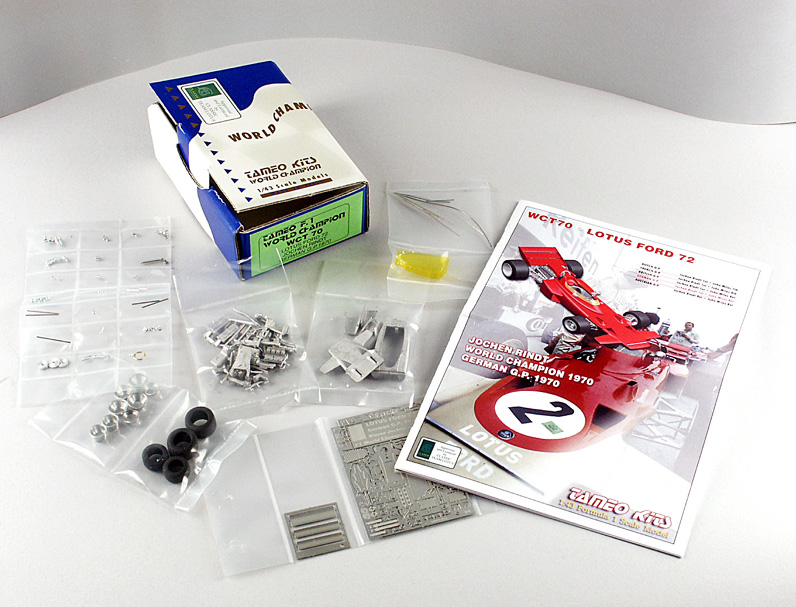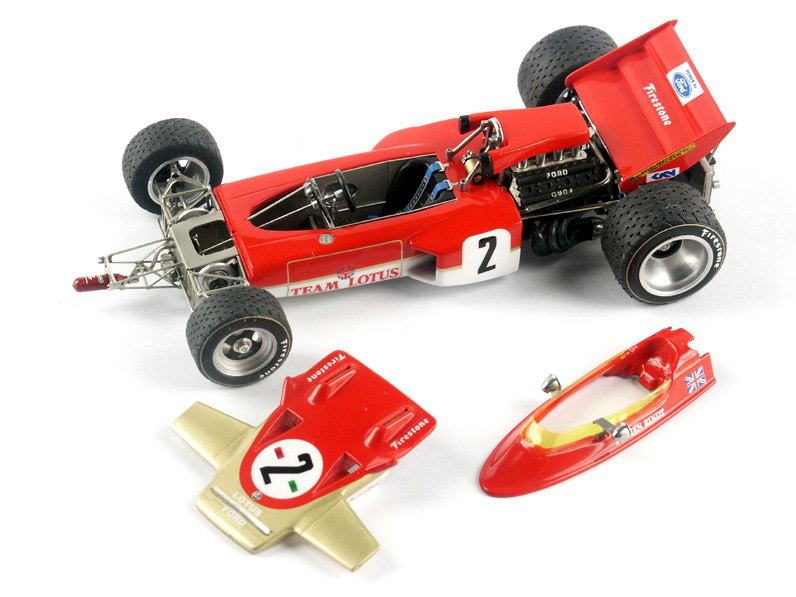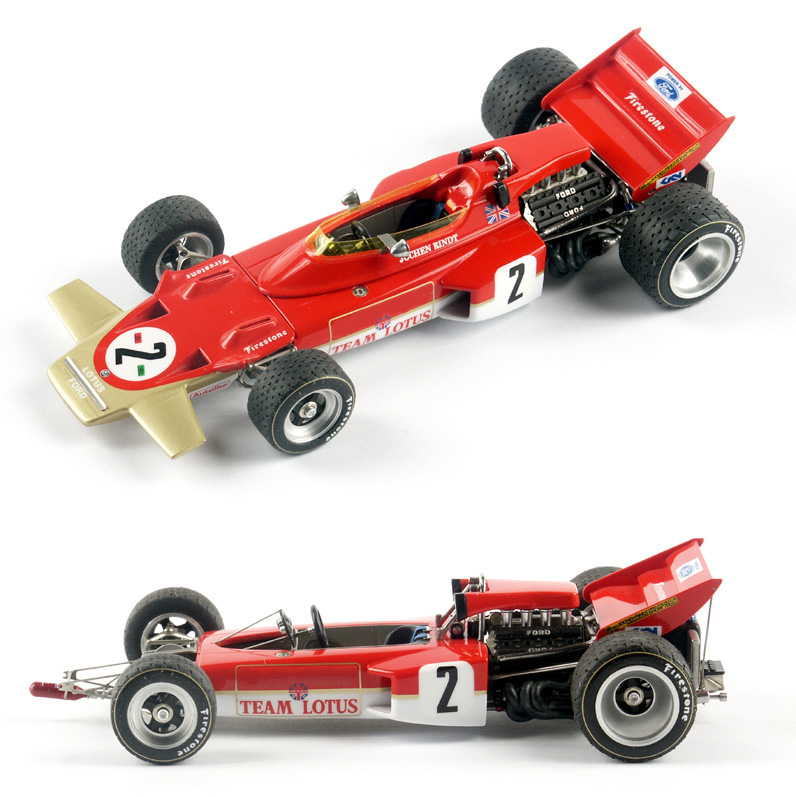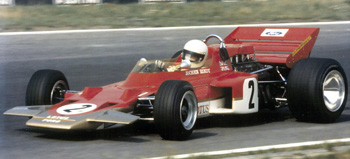Pick a language
Focus
WCT70 – Lotus Ford 72 German GP 1970
There are many possible variants to the Lotus 72 model. To begin with, we have decided to recreate the 1970 version, the racing car that allowed Jochen Rindt to win the world title that year. The chosen race is the German Grand Prix in Hockenheim, which is where the Austrian champion had his last victory. It was not easy to find all the documentation relating to that specific version. There are many Lotus 72 models available that have been restored, but none of them can be currently found in the original configuration of the 1970 Grand Prix. Research has taken months and we need to thank Clive Chapman and the Classic Lotus Team for the precious assistance in supplying photographs and original designs of the 1970 world champion single-seater.
The photograph shows the kit in it’s standard configuration. The box is the usual kind, which contains all the “World Champion” series models. The smaller parts are enclosed in small transparent PVC boxes, in order for them to be easily seen, recognised and protected. Many parts are actually so small, that it could be very easy to lose them as soon as the box is opened. The illustrative leaflet shows the step by step assembly stages of this model, which includes more than 300 parts! There are also photographs of the English single-seater racing at Hockenheim and a series of rare photographs showing the specific technical details, like the suspensions, engines and spoilers. Like with many of the Tameo kits, there are two sets of decals supplied with this model.
It maybe superfluous to describe what the photographs show with great clarity. We will try anyhow. The back part has been reproduced without compromises. The assembly requires patience and great precision. It is fundamental to follow the chronological order indicated in the instruction manual; if carried out correctly, the result will be incredible. The engine and the gears are casted in white metal, whilst the accessories have been created using the photoengraving process and in precise shiny aluminium turnings. It is nearly a shame that the back spoiler is so large that it practically covers such a complete and perfect mechanical area. The engine heads have FORD printed, but the kit also provides decals, should one wish to remove the fusion versions. The back view shows the care and precision for detail. The water tank with it’s relating radiator located at it’s side, should be noted. The structure that sustains the exhaust and the battery extends up to the bulkhead of the back spoiler, making the model exactly like the original.
Returning to the back spoiler, the three wings that make it up, have been created using the photoengraving process and have been modelled using a special steel mould which provides the wings with the classic rounded form, which is typical of the wings of that era. The right-hand photograph shows the true reproduction of the 1970 Firestone tread tyre. The classic gold rim decal showing the printed Firestone brand name, is included in order to complete the external back part of the tyre. The front area is probably the best part. The monocoque and the various frames that sustain the suspensions have been produced, even though the sizes have been extremely reduced. There are the pedals, the brake discs and related drive shafts, the brakes oil tank and the original extinguisher that has been assembled in an overhanging way onto a photoengraving structure. The only compromise that we have had to accept refers to the geometry of the front suspension; unfortunately, as they are too small, we have been unable to insert the shock absorber rods. I am certain that the more precise collectors will be able to assemble them with the use of the photographs supplied with the kit.
The chassis has been made using the photoengraving process. All you need to do is bend the various parts and assemble them. Those with more experience should be able to eliminate glue, preferring to solder. The photoengraved monocoque is extremely realistic if it is polished with care. It’s superficial appearance is identical to the original car, whilst should it be painted, it would become more like a “model”.
The accessories on the dashboard are turned with the addition of decals for the quadrants. The seatbelts can be found at 4 different points, the gear stick well-rounded, as are the rear-view mirrors. The windscreen, which has been created in yellow thermo-shaped transparent PVC, is supplied in two forms; this, in case the first one should break whilst its being cut to adapt it to the driver’s compartment.
If all the assembly stages to be found in the instruction manual are followed through correctly, the model should be able to be opened and closed without any problem. It is difficult to say whether it looks better open, leaving the chassis and the suspensions to be seen, or closed as if ready for a race.
The photographs highlight the turned and shiny rims and the way they are perfectly decorated. By the way, the white part to be found in the lower part of the body, is supplied with decals in order to allow those with less experience to decorate the bodywork with less difficulty. For those with higher requirements who wish to paint the white part, there is also a gold thread supplied which separates the red colour from the white.
This is one of our best models at the moment. The basic equipment of this kit allows for the assembly as seen in the photograph. It is obvious that the more expert and skilled the model maker is, the more effort he will make in finding the best way to improve it, adding other parts, like for example, all the electrical wires.
This excellent base will be useful in the future for the production of other versions of the Lotus Ford typ 72.
THE HISTORY – Lotus Ford 72 1970 German GP
In 1970 it won the World Championship for the pilots and the racing car manufacturer, repeating this double victory in 1972. Twenty victories in total, as well as three successes outside the championship. As with all Colin Chapman cars, the car had some very innovative and ingenious solutions, especially concerning it’s aerodynamics. For six championship seasons, the Lotus 72 was the fighting horse for the English company, who also acquired the racing car manufacturers’ title in 1973. One can therefore talk about one of the most long-lived single-seaters to have ever competed the circuits.
In 1970, the Lotus 72 replaced the Typ 49, which was driven by Jochen Rindt for half the season. The Austrian pilot won four consecutive Grand Prix’ with the “72/2” and arrived at Monza to compete in the Grand Prix with 11 advantage points against his nearest rival. During the official trials on the Saturday, he accidentally drove off the circuit and died upon the terrible impact against the guard rail, which also destroyed the single-seater.
Nel 1970 e nel 1971 la “Typ 72” era verniciata nel classico bianco e rosso dello sponsor Gold Leaf. Dal 1972 le monoposto di Colin Chapman sono diventate nere e sponsorizzate dalla John Player Special.
